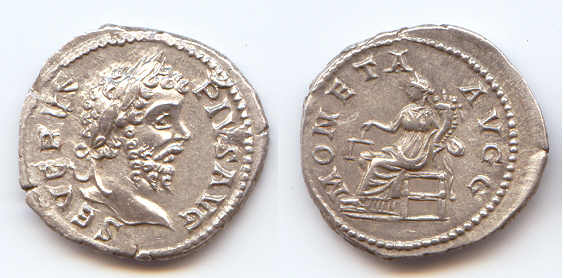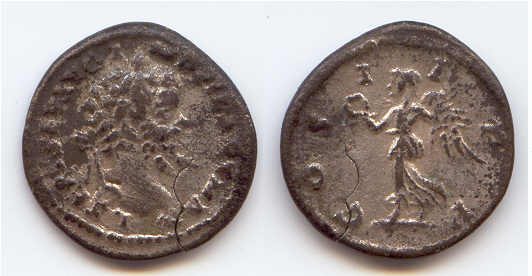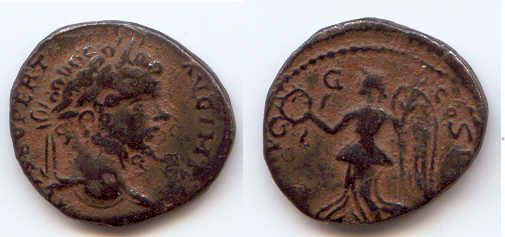 19 mm. 6:30. 3.29 grams.
19 mm. 6:30. 3.29 grams.Septimius Severus (AD 193-211) imitations
There are several types of imitations
1) good silver (These are very rare)
2) base silver, but silver throughout (also rare)
3) fourrees, struck over base-metal flans wrapped with silver foil. These are common, but less common than the gray-metal and copper imitations.
4) lightly silvered -- in my opinion, these may use the technology of the surface-silvered coins of Probus and Aurelian
5) gray metal, cast and therefore in official style. Were these ever silvered?
6) copper, cast and therefore in official style. Are these cores? Were these ever silvered?
 19 mm. 6:30. 3.29 grams.
19 mm. 6:30. 3.29 grams.
Spectacular pure silver imitation. Very rare.
SEVERVS PIVS AVG, laureate head right
/MONETA AVGG, Moneta seated left holding balance and cornucopiae
Reference: BMC p.227 #12 in "Appendix of doubtful hybrids" cited from L. A. Lawrence collection.
RIC 163 reverse.
ex Harlan J. Berk, sold by Curtis Clay, a top expert on Septimius Severus.

17-16 mm. 7:00. 2.35 grams.
Base silver, not a fourre. The discoloration is dirt on top of the surface. Weak strike.
The letter-like forms are quite illegible, but suggest, on the reverse, possibly MONETA AVGG.
From a Bulgarian dealer, so possibly from that region.
 Septimius Severus obverse combined with a Caracalla reverse.
Septimius Severus obverse combined with a Caracalla reverse.Excellent British fourree. Plating nearly intact.
SEPT SEV PERT AVG IMP, laureate head right
TRP VIVIM P VI COS IIII P 9approximately)
Prototype: BM --, but cf. #140, page 382 w. TRPVIVIIMPIICOSIIII in similar style and very similar reverse type, noted at plated, under "Septimius, Caracalla, and Geta, barbarous and irregular."
 17 mm. thin. 6:00. 2.16 grams.
17 mm. thin. 6:00. 2.16 grams.
Some silver left on the obverse, but toned, and almost none left on the reverse.
IMP CASE L SEP SEV....COS II
/....VIII COS II ...., female standing left, holding patera
Obverse legend of AD 194 from an Eastern mint, but reverse date of 200.
 19mm. 12:00. 2.69 grams.
19mm. 12:00. 2.69 grams.
Imitation with a thin surface-silvering, much like that seen on coins of Probus and Aurelian. Did the counterfeiters discover the technology first?
L SEPT SEV AVG IMP XI PART MAX, laureate head right
/COS II PP, Vicotry advancing left with wreath and palm.
Prototype: BMC (S&C) 655-6 [not illustrated, 3.60 and 2.78 grams] p. 286. #657-9, plate 44.4 has COS III (3.54 grams, with others down to 2.45)
 18mm. 6:00. 2.55 grams.
18mm. 6:00. 2.55 grams.
gray metal. Cast - edge seem visible from side. Rough surrface.
SEVERVS PIVS AVG, laureate head right
/PM TRP XV - COS III PP, Winged Victory right, naked to waist, writing on round shield, set on palm tree, left foot on helmet.
Prototype: BMC 536, p. 263 (AD 207) plate 41.13. RIC 211, p. 118, plate 6.18 "C". Hill 915, p. 25 "C2" (Victory in Africa).
Coppery. No sign of silver, but a nice cast. Parts of the edge join are visible from the side.
SEVERVS PIVS AVG, laureate head right
/PM TRP XIII COS III PP, Jupiter standing let, holding thunderbolt and staff, eagle at feet left
Prototype: old Sear 1774. RIC 196 p. 117 "C". BMC 473 p. 250 plate 39.17. Hill 719 "AD 205"
 18 mm. 6:00. 3.32 grams.
18 mm. 6:00. 3.32 grams.
Black and tan. I suppose this could just be tarnished official piece, but the wreath looks too large and Victory's robes flow dramatically.
[L SEPT] SEV PERT - AVG IMP [...]
[..]VG-G - COS I[...], Victory left holding large wreath and palm.
Prototype: see BMC plate 43.12 "VICT AVG-G-COS II PP" by deduction from Seaby RSC 694 photo.
Possibly IMP XI from Eastern mint, AD 198.
RIC page 103ff, #1200, p. 105.
 17 mm. 6:00. 2.59 grams.
17 mm. 6:00. 2.59 grams.
Patinated, with encrustations on the obverse.
SEVERVS PIVS AVG
/VOTA SUSCEPTA XX, Severus sacrificing over tripod altar
Prototype: old Sear 1698v., RIC 308. BMC 375, plate 37.2, page 224 "AD 208".
Continue with the page on imitations of Julia Domna.
Return to the page on Severan imitations.
Return to the main page on ancient Roman imitations.
See also Doug Smith's off-site page on Severan imitations. (But, go there and you may get so involved you never come back!)